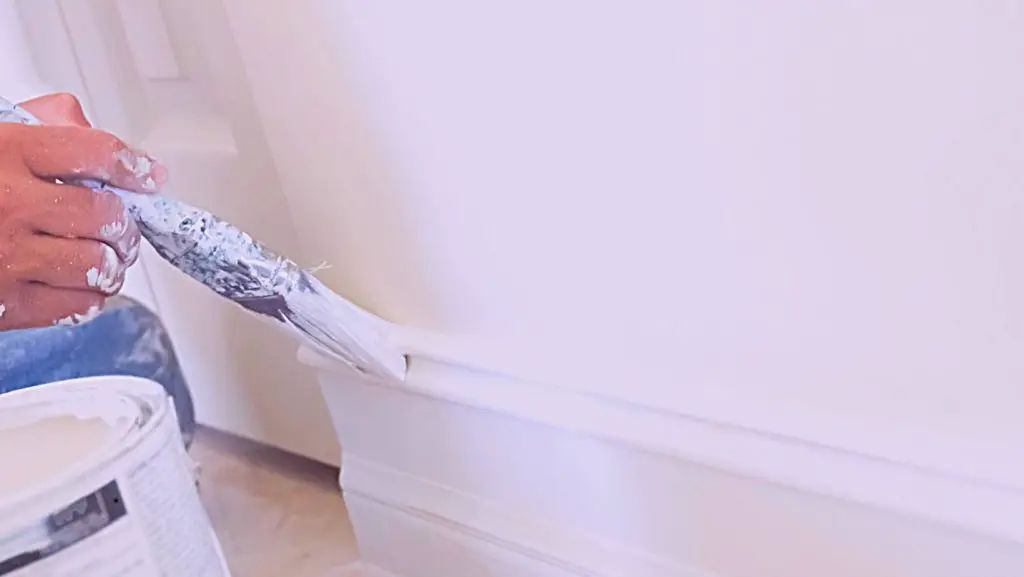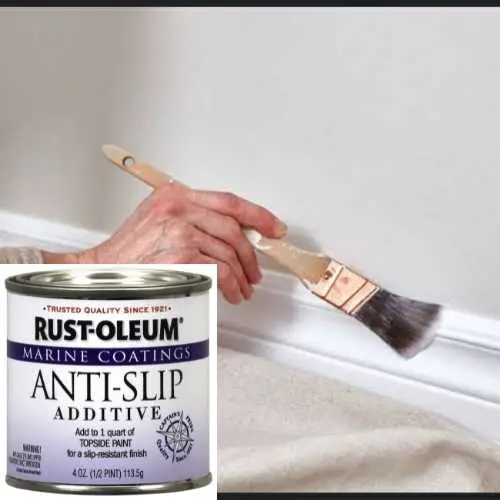You’ve just finished painting your walls, and you’re about to start on the trim. When you grab your paintbrush, you find that the paint won’t stick to the trim. And now you might wonder why my paint is not sticking to the trim.
This can be incredibly aggravating, especially when you’re on a tight timeline. Chances are, it’s not you. It’s the paint. In most cases, this is due to a lack of adhesion between the trim and the wall surface. But there can be many other reasons as well.
This article discusses some common reasons why paint isn’t sticking to trim, as well as what you can do about it.

The Reasons Why My Paint Doesn’t Stick to The Trim
Painting to achieve a professional-looking finish takes skill, practice, and the right products. But even if you have all of those things, there are still situations where the paint just won’t stick. When this happens, it’s usually due to one (or more) of the following reasons:
1. Incorrect Surface Preparation
If the trim isn’t properly prepared, the paint won’t adhere correctly and is likely to peel. To prepare the trim, clean it with a degreaser or trisodium phosphate (TSP) solution. Once the trim is clean, sand it down to create a smooth surface. If any cracks or holes are in the trim, fill them with caulk or putty before painting.
2. Incorrect Paint Type
Another reason why paint may not be sticking to the trim is that you’re using the wrong type of paint. For example, if you’re painting over oil-based paint with water-based paint, the new paint won’t adhere correctly and may peel. Make sure to use the same type of paint as the existing paint to adhere correctly.
3. Poor Quality Paint
If you’re using poor-quality paint, you will likely have trim peeling off. This is because cheap paint doesn’t contain all the necessary ingredients for proper adhesion. When choosing paint, make sure to select a high-quality product that is designed for use on trim.
4. Excess Moisture
Paint can also peel off trim due to excessive moisture. If the trim is too wet when you start painting, the paint will not adhere correctly and will likely peel once it dries. To avoid this problem, make sure to wait until the trim is completely dry before starting to paint.
5. Temperature Extremes
Another factor that can affect paint adhesion is temperature extremes. If it’s too hot or cold outside, the paint may not dry correctly and is more likely to peel. For best results, try to paint when the temperature is between 50° and 90° Fahrenheit.
6. Failing to Apply a Primer
If you’re painting over bare wood or other porous surfaces, it’s important to apply a primer before painting. This will help the paint to adhere correctly and will prevent it from peeling. A primer may not be necessary if you paint over previously painted surfaces.
7. Improper Painting Technique
Finally, if you don’t apply the paint correctly, it’s more likely to peel off the trim. When painting, always start at the top of the trim and work your way down. Use even strokes, and don’t overload your brush with paint, so you don’t create drips or runs.
Why Is My Paint Peeling Off the Edges of the Wood Trim?
Peeling paint from wood trim is a common problem when the paint film becomes loose, cracks, and rolls at the exposed edges. The problem is caused by the wet wood expanding and contracting from moisture and temperature changes, which loosen the paint film.
The best way to prevent this problem is to use a high-quality primer for exterior surfaces. It will help to create a barrier between the paint and the wood, and it will also help to seal in the moisture.
Moreover, applying a top coat of paint specifically for exterior surfaces is important. This will provide an additional layer of protection against the elements and help to keep the paint film in place.
Why Is My Newly Painted Trim Peeling?
One of the most common reasons is painting over dirty walls. If the surface is not properly cleaned before painting, the dirt and dust can prevent the paint from adhering correctly, resulting in flaking. Excess moisture can also cause paint to peel, so it’s important to ensure the area is thoroughly dry before painting.
Improper prep can also be a cause of peeling paint. In the case of painting over a glossy surface, you must use a primer to help the new paint adhere. Finally, applying latex paint over oil paint can also cause problems. The two types of paint are incompatible, and the latex paint will eventually begin to peel.
Why Is My Gloss Paint Not Sticking to the Trim?
When you’re painting, choosing the right paint for the job is important. For instance, if you’re trying to achieve a high-gloss finish, you’ll need to use glossy paint. Even if you use the right paint, you may still have problems if the surface you’re trying to paint is oily, greasy, or otherwise slick.
In such cases, the paint will simply refuse to adhere. The same is true of surfaces that are already flaking or peeling; unless you use a peel-stopping primer, you’ll need to scrape off all the loose paint before attempting to apply any new coats.
You can also clean an oily surface with soap and water or sand a glossy surface until it’s dull. Using these tricks, you can ensure that your gloss paint will stick to even the most difficult trim surfaces.
What to Add to Paint to Prevent Slipping from Trim?
The downside of paint is that it can get slippery when wet. This can pose a serious safety hazard, especially on stairs or other high-traffic areas. There are a few different ways to make the paint less slippery.
One option is to add an anti-slip additive to the paint before applying it. These additives come in both powder and liquid form, and they work by creating a rough surface that provides traction when wet.
Another option is to use textured paint, which contains an anti-slip additive. These paints are ideal for areas where slip resistance is critical, such as in bathrooms or kitchens. If you’re a little smart, you can choose the right paint finish to help keep your home safe and slip-free.

How Do You Get Paint to Stick to Old Trim?
If you’re painting a room with wood or concrete trim, you’ll want to take extra steps to ensure that the paint adheres well to the surface. One of the best ways to do this is to sand the trim using 220-grit sandpaper lightly. This will create a slightly rougher surface for the paint to cling to.
You should also ensure that any old paint or varnish is removed from the trim before you begin painting. Otherwise, the new paint may not adhere properly. Once you’ve prepped the surface, you can apply a primer and start painting.
Frequently Asked Questions
While you have learned about the problems that can occur when painting trim and how to avoid them, you may still have some questions. Here are some of the most FAQs about painting trim.
1. Can You Paint Over Peeling Paint on the Trim?
No, it’s not. If the paint is peeling due to a failure in the underlying surface, then painting over it will only serve to mask the problem. Eventually, the new paint will also begin to peel. Before painting, you have to remove the old paint and prep the surface properly.
2. Do I Need to Prime the Trim Before Painting?
Yes. Most trim is made of wood, and porous wood tends to absorb the paint, resulting in an uneven surface. By priming the trim before painting, you set up a barrier between the paint and the trim, which helps to prevent the paint from being absorbed.
3. Can I Paint the Trim Without Sanding?
You don’t have to sand before using paint. But if the surface has never been painted, you will want to use a primer. If a previously painted surface is in good shape, just make sure it’s clean and dry before painting. You may need to sand the surface if it’s in bad shape. Otherwise, just paint away.
Final Words
There you have it. These are the most common problems to avoid when painting trim. One of the final pieces of advice is that you should always consult with a professional painter to get the best results. They will be able to help you choose the right paint for your project and ensure that the job is done properly.
With some knowledge and careful preparation, you can also ensure that your paint job will turn out great. Just remember to take your time, use the right products, and prep the surface properly. Wishing you success with your endeavor.

S. Pushon is a paint expert, self-taught artist, and currently working as an adviser in the paint industry as a Quality Improvement and Development Assistant.
An artist by heart, he draws remarkable art pieces and as a professional paint industry individual, he seeks the insight and shares with enthusiasts. Read more…

